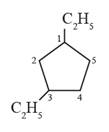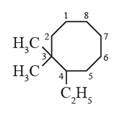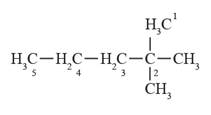
a.
Interpretation: To give the correct name and draw the structural formula of the compound.
Concept Introduction: Structural formulas are used to give the structures for the compounds. It helps in telling the exact number of atoms that are present in a compound along with
a.
Answer to Problem 85A
The correct name for 4-methyl hexane is 3-methyl hexane.
Explanation of Solution
The given compound is 4-methyl hexane.
The correct name for this compound is 3-methyl hexane as per
Thus, the structural formula of 3-methyl hexane is as follows:

b.
Interpretation: To give the correct name and draw the structural formula of the compound.
Concept Introduction: Structural formulas are used to give the structures for the compounds. It helps in telling the exact number of atoms that are present in a compound along with functional groups if present.
b.
Answer to Problem 85A
The correct name for the compound is 1,3-diethyl cyclopentane.
Explanation of Solution
The given compound is 1,4-diethyl cyclopentane.
The correct name for this compound is 1,3-diethyl cyclopentane as per IUPAC nomenclature as the numbering should be done in order to take substituents into consideration.
Thus, the structural formula of 1,3-diethyl cyclopentane is as follows:

c.
Interpretation: To give the correct name and draw the structural formula of the compound.
Concept Introduction: Structural formulas are used to give the structures for the compounds. It helps in telling the exact number of atoms that are present in a compound along with functional groups if present.
c.
Answer to Problem 85A
The correct name for the compound is 3,3-dimethyl-4-ethyl octane.
Explanation of Solution
The given compound is 3,3methyl-4-ethyl octane.
The correct name for this compound is 3,3-dimethyl-4-ethyl octane as there are two methyl substituents on the third carbon atom thus “di” must be written in the IUPAC name.
Thus, the structural formula of 3,3-dimethyl-4-ethyl octane is represented as follows:

d.
Interpretation: To give the correct name and draw the structural formula of the compound.
Concept Introduction: Structural formulas are used to give the structures for the compounds. It helps in telling the exact number of atoms that are present in a compound along with functional groups if present.
d.
Answer to Problem 85A
The correct name for the compound is 2,2-dimethyl pentane.
Explanation of Solution
The given compound is 4,4-dimethyl pentane.
The correct name for this compound is 2,2-dimethyl pentane as per IUPAC nomenclature as the numbering should be done in order to take substituents into consideration.
Thus, the structural formula of 2,2-dimethyl pentane is as follows:

e.
Interpretation: To give the correct name and draw the structural formula of the compound.
Concept Introduction: Structural formulas are used to give the structures for the compounds. It helps in telling the exact number of atoms that are present in a compound along with functional groups if present.
e.
Answer to Problem 85A
The correct name for the compound is 3-methyl octane.
Explanation of Solution
The given compound is 2-ethyl heptane.
The correct name for this compound is 3-methyl octane as per IUPAC nomenclature as the numbering should be done by looking at the longest continuous carbon chain.
Thus, the structural formula of 3-methyl octane is as follows:

f.
Interpretation: To give the correct name and draw the structural formula of the compound.
Concept Introduction: Structural formulas are used to give the structures for the compounds. It helps in telling the exact number of atoms that are present in a compound along with functional groups if present.
f.
Answer to Problem 85A
The correct name for the given compound is methyl benzene.
Explanation of Solution
The given compound is phenyl methane.
The correct name for this compound is methyl benzene as per IUPAC nomenclature priority is given to the phenyl ring over the methyl group.
Thus, the structural formula of methyl benzene is as follows:

Chapter 22 Solutions
Chemistry 2012 Student Edition (hard Cover) Grade 11
- how to get limiting reactant and % yield based off this data Compound Mass 6) Volume(mL Ben zaphone-5008 ne Acetic Acid 1. Sam L 2-propanot 8.00 Benzopin- a col 030445 Benzopin a Colone 0.06743 Results Compound Melting Point (°c) Benzopin acol 172°c - 175.8 °c Benzoping to lone 1797-180.9arrow_forwardAssign ALL signals for the proton and carbon NMR spectra on the following pages.arrow_forward7.5 1.93 2.05 C B A 4 3 5 The Joh. 9 7 8 1 2 7.5 7.0 6.5 6.0 5.5 5.0 4.5 4.0 3.5 3.0 2.5 2.0 1.5 1.0 ppm 9 7 8 0.86 OH 10 4 3 5 1 2 7.5 7.0 6.5 6.0 5.5 5.0 4.5 4.0 3.5 3.0 2.5 2.0 1.5 1.0 ppm 9 7 8 CI 4 3 5 1 2 7.0 6.5 6.0 5.5 5.0 4.5 4.0 3.5 3.0 2.5 2.0 2.21 4.00 1.5 2.00 2.07 1.0 ppm 2.76arrow_forward
- Assign the functional group bands on the IR spectra.arrow_forwardFind the pH of a 0.120 M solution of HNO2. Find the pH ignoring activity effects (i.e., the normal way). Find the pH in a solution of 0.050 M NaCl, including activityarrow_forwardPlease help me answer these three questions. Required info should be in data table.arrow_forward
- Draw the major organic substitution product or products for (2R,3S)-2-bromo-3-methylpentane reacting with the given nucleophile. Clearly drawn the stereochemistry, including a wedged bond, a dashed bond and two in-plane bonds at each stereogenic center. Omit any byproducts. Bri CH3CH2O- (conc.) Draw the major organic product or products.arrow_forwardTartaric acid (C4H6O6) is a diprotic weak acid. A sample of 875 mg tartaric acid are dissolved in 100 mL water and titrated with 0.994 M NaOH. How many mL of NaOH are needed to reach the first equivalence point? How many mL of NaOH are needed to reach the second equivalence point?arrow_forwardIncluding activity, calculate the solubility of Pb(IO3)2 in a matrix of 0.020 M Mg(NO3)2.arrow_forward
 ChemistryChemistryISBN:9781305957404Author:Steven S. Zumdahl, Susan A. Zumdahl, Donald J. DeCostePublisher:Cengage Learning
ChemistryChemistryISBN:9781305957404Author:Steven S. Zumdahl, Susan A. Zumdahl, Donald J. DeCostePublisher:Cengage Learning ChemistryChemistryISBN:9781259911156Author:Raymond Chang Dr., Jason Overby ProfessorPublisher:McGraw-Hill Education
ChemistryChemistryISBN:9781259911156Author:Raymond Chang Dr., Jason Overby ProfessorPublisher:McGraw-Hill Education Principles of Instrumental AnalysisChemistryISBN:9781305577213Author:Douglas A. Skoog, F. James Holler, Stanley R. CrouchPublisher:Cengage Learning
Principles of Instrumental AnalysisChemistryISBN:9781305577213Author:Douglas A. Skoog, F. James Holler, Stanley R. CrouchPublisher:Cengage Learning Organic ChemistryChemistryISBN:9780078021558Author:Janice Gorzynski Smith Dr.Publisher:McGraw-Hill Education
Organic ChemistryChemistryISBN:9780078021558Author:Janice Gorzynski Smith Dr.Publisher:McGraw-Hill Education Chemistry: Principles and ReactionsChemistryISBN:9781305079373Author:William L. Masterton, Cecile N. HurleyPublisher:Cengage Learning
Chemistry: Principles and ReactionsChemistryISBN:9781305079373Author:William L. Masterton, Cecile N. HurleyPublisher:Cengage Learning Elementary Principles of Chemical Processes, Bind...ChemistryISBN:9781118431221Author:Richard M. Felder, Ronald W. Rousseau, Lisa G. BullardPublisher:WILEY
Elementary Principles of Chemical Processes, Bind...ChemistryISBN:9781118431221Author:Richard M. Felder, Ronald W. Rousseau, Lisa G. BullardPublisher:WILEY





